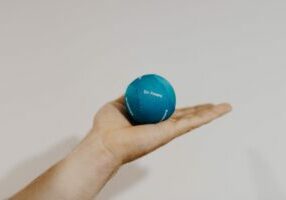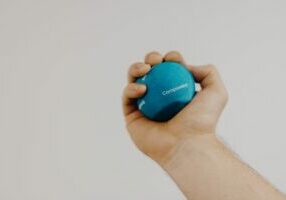
The left side of my upper back has a constant tight feeling that’s been there for about 2 weeks. I’ve taken a break from working out for about 1.5 weeks now hoping it would go away but it hasn’t. I’m trying to give it as long as it needs to rest by not lifting but it doesn’t seem to be getting better and I’m getting desperate. – Don
Tight muscles HURT! And they cause reduced range of motion, pull your joints out of alignment and put you at risk for injury. If that is not bad enough, they also slow you down. Tight muscles often do not have the same contractile capacity so don’t work as well to power you up.
Here’s three reasons why your
Reason #1: Too Much Time in a ‘Short’ Position
When a muscle is held in a consistently shortened position and not allowed to elongate completely (stretch) it will adapt to that position. Like they say: “if you don’t use it, you lose it”. The longer the muscle stays shortened, the harder it is to elongate it. This is probably the closest match to what we think of as “tight” muscles. Usual areas subject to this: quads, hip flexors, pecs, biceps, neck muscles, finger flexors, and the
A great example is the hip flexor when sitting. It’s completely shortened for hours a day; even if you don’t sit at a desk for a living you probably sit more than you realize. After hours and days and years of this it will remain shortened when we stand up leading to an altered pelvic position and constant tension on the low back.
The Solution: Stretching, Yoga, Functional Range Conditioning
Really, any sort of stretching will do, if you know how to do it. That’s why yoga is so great, it stretches you through all ranges of motion in all joints safely and will care lead by a professional. Practices like Tai Chi move you through full ranges of motion in a controlled manner, relieving stress and tension along the way.
Reason #2: Injury (Acute or Chronic) and Soft Tissue Overload
Muscles are like ropes, hundreds of fibers make up one unit. When you “pull” or “tear” a muscle, either by injury over by overuse, you strain it by fraying a certain amount of those small fibers. When a strain happens the body lays down scar tissue to patch the injury. But scar tissue is like a patch on jeans, it doesn’t have the elastic properties that muscle fibers do. So if it heals in a shortened state it will stay shortened and be difficult to elongate leading to “tight” feeling muscles.
The Solution: Manual Therapy and Foam Rolling
Manual therapy includes Active Release Technique, Cupping, Myofascial Release, Instrument Assisted Soft Tissue Mobilization, Massage, etc. Having a professional put their hands on you and work out the scar tissue is an extremely effective and quick way to recover.
Good manual therapy is simply the best way to help an injury heal properly. No matter how old the injury is, myofascial release is the way to go.
Our team at Head 2 Toe is awesome at this! For at home care, foam rolling and lacrosse ball work is the good stuff. If you don’t know how to foam roll, join us at one of our FREE foam rolling clinics.
Reason #3: Too Much Time in ‘Long’ Positions
In the same way your muscles can adapt to being short, they can stay elongated as well. They never fully shorten through contraction and therefore become weak. Common areas: upper back, low back, hamstrings, bottom of the foot muscles, anterior neck muscles.
Think about a rope and pulley system, if you pull on one side of the rope the other will become taught and as long as possible. That’s usually what our hamstrings are doing when they feel “tight”.
The quads and hip flexors are on the other end of that pulley system in a shortened state causing constant tension on the hamstrings. This is why stretching will not alleviate your hamstring tightness.
If I could put that sentence on a billboard I would. If banging your head against the wall doesn’t get rid of your headache, try another approach.
The Solution: Strengthening
Let me be specific: functional, safe, controlled strengthening. Obviously, the best is with a trainer who really knows what they’re doing. You can do it on your own but the odds are 20 hours of searching the web probably won’t get you the education you need. People go to school for years to know how to do this, let them do it.
In Summary:
If you are feeling pain and stiffness, feel limited at the gym, have a chronic joint issue that just won’t go away, or perhaps you are unable to hold your chiropractic adjustment, you should book an appointment to come see us! Our doctors are experts in manual therapy procedures to loosen up your tight muscles. Give us a call to schedule or book online.
If you want to book your appointment online, just click below to book online (limited online bookings
Exercises You Can Do at Home after a Visit to the Chiropractic Clinic
Stay active at home with exercises from ‘Exercises You Can Do at Home after a Visit to the Chiropractic Clinic’.
Read MoreAthletic Therapy: A Vital Component in Sports Rehabilitation
Discover the importance of athletic therapy in sports rehabilitation in our insightful blog on ‘Athletic Therapy: A Vital Component in Sports Rehabilitation’.
Read MoreA Comprehensive Guide to Spinal Therapy for Athletes
Discover the benefits of spinal therapy for athletes in our comprehensive guide ‘A Comprehensive Guide to Spinal Therapy for Athletes’.
Read MoreHow Chiropractic Techniques are Advancing in Pain and Injury Treatment
Discover the latest advancements in pain and injury treatment through innovative chiropractic techniques.
Read MoreSpine Rehabilitation: How Corrective Exercises Can Help with Posture and Pain Relief
Discover how corrective exercises in spine rehabilitation relieve pain and improve posture – read more now!
Read MoreCorrective Exercises: Your Secret Weapon Against Chronic Pain
Combat chronic pain with corrective exercises featured in ‘Corrective Exercises: Your Secret Weapon Against Chronic Pain’.
Read More




